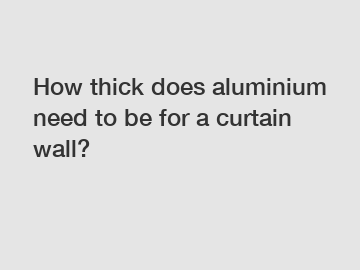Aluminium is widely used in the construction industry due to its lightweight properties, durability, and resistance to corrosion. When it comes to curtain walls, which are non-structural cladding systems typically made of aluminium, one important consideration is the thickness of the aluminium material used. The thickness of the aluminium for a curtain wall depends on various factors such as wind loads, building height, and design aesthetics.
**Factors influencing the thickness of aluminium for a curtain wall**.
Wind loads are a critical factor in determining the thickness of the aluminium for a curtain wall. The aluminium panels used in a curtain wall must be able to withstand the force of wind blowing against the building. The higher the wind loads in a particular location, the thicker the aluminium material needed for the curtain wall.

Building height is another important factor to consider when determining the thickness of aluminium for a curtain wall. Taller buildings experience greater wind loads, which means that thicker aluminium material is required to ensure the structural integrity of the curtain wall. Additionally, the weight of the aluminium affects the overall stability of the curtain wall, especially for taller buildings.
Design aesthetics also play a role in the decision-making process regarding the thickness of aluminium for a curtain wall. Thicker aluminium profiles can provide a bolder, more robust appearance to the curtain wall, while thinner profiles may offer a sleeker, more minimalist look. Architects and designers must balance the structural requirements of the curtain wall with the desired aesthetic outcome to create a successful building façade.
**Choosing the right thickness of aluminium for a curtain wall**.
When selecting the thickness of aluminium for a curtain wall, it is essential to consult with structural engineers, architects, and aluminium suppliers to ensure that the chosen material meets the specific requirements of the project. Factors such as building location, exposure to wind, building height, and design preferences all need to be taken into account when determining the right thickness of aluminium for a curtain wall.
Thicker aluminium profiles offer greater strength and durability, making them suitable for high-rise buildings or buildings located in areas prone to high wind loads. Thinner aluminium profiles, on the other hand, may be more suitable for low-rise buildings or buildings with less exposure to wind. Additionally, the finish of the aluminium material can also impact the overall appearance of the curtain wall, so it is essential to consider both the thickness and finish of the aluminium when designing a curtain wall.
In conclusion, the thickness of aluminium for a curtain wall depends on various factors such as wind loads, building height, and design aesthetics. By carefully considering these factors and consulting with experts in the field, it is possible to select the right thickness of aluminium to create a structurally sound and visually appealing curtain wall for any building project.
If you have any questions or need assistance in determining the right thickness of aluminium for your curtain wall project, please do not hesitate to contact us.
For more information, please visit aluminium extrusions for solar panels, What is the difference between V slot and T-slot?, Heat Sink Aluminum Extrusion Supplier.



Comments
All Comments (0)